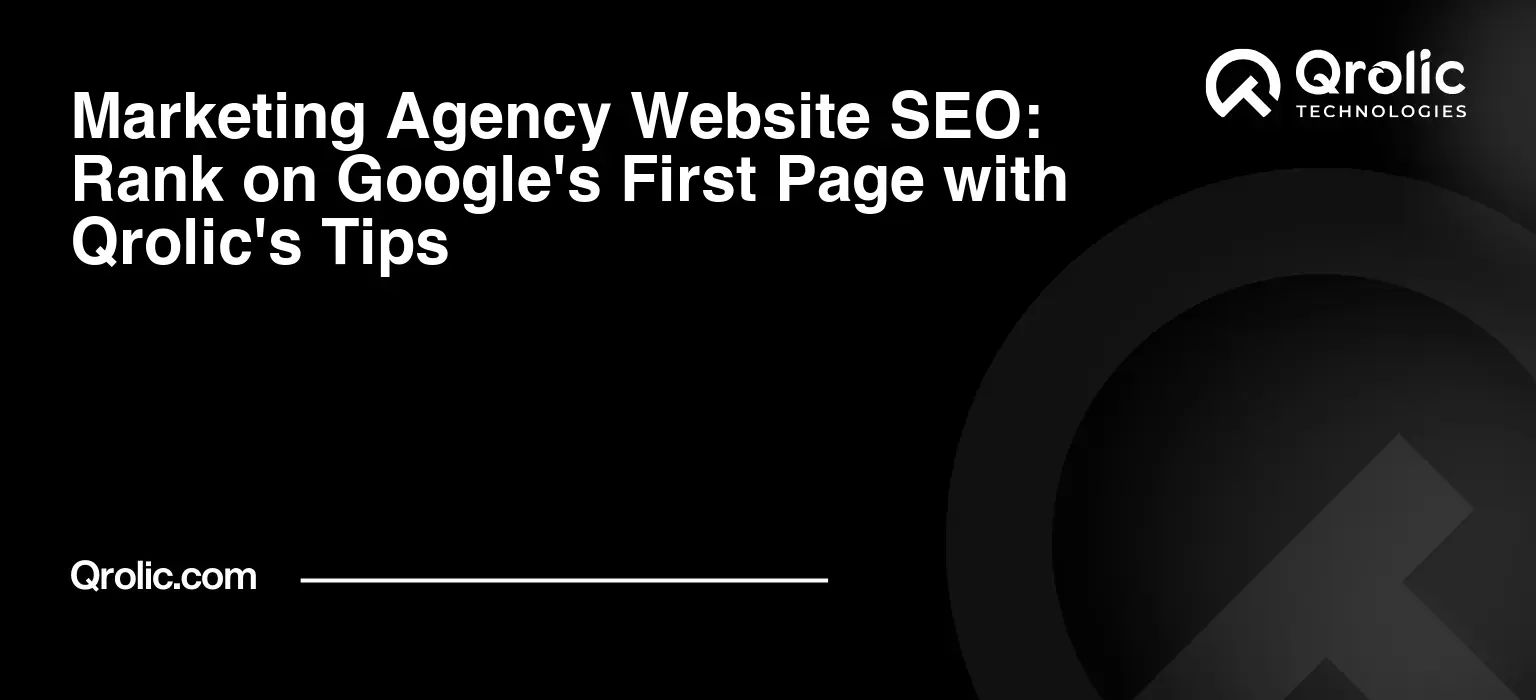Choosing the right email marketing tool is crucial for connecting with your audience, nurturing leads, and driving sales. With so many options available, it can be overwhelming to decide which platform is the best fit for your specific needs. Two of the most popular choices are Mailchimp and ConvertKit. Both offer a wide range of features and capabilities, but they cater to different types of users and businesses. This comprehensive guide will delve deep into a detailed comparison of Mailchimp vs ConvertKit, exploring their strengths, weaknesses, pricing structures, and ideal use cases, helping you determine which email marketing tool reigns supreme for your success. Let’s find out which email marketing automation software is the perfect fit for your business growth.
Quick Summary:
- Mailchimp suits beginners needing broad marketing tools.
- ConvertKit is ideal for creators with advanced automation needs.
- Your choice depends on specific goals and budget.
- Try both platforms to find your perfect fit.
Table of Contents
- Understanding the Basics: Mailchimp and ConvertKit
- Round 1: Core Features & Functionality
- Mailchimp: A Jack-of-All-Trades
- ConvertKit: Focus on Creators and Personalization
- Round 2: Ease of Use and User Interface
- Mailchimp: Familiar but Sometimes Cluttered
- ConvertKit: Streamlined and Focused
- Round 3: Pricing and Value for Money
- Mailchimp: Tiered Pricing with Complexity
- ConvertKit: Simple and Transparent Pricing
- Round 4: Email Deliverability
- Mailchimp: Reputation Management is Key
- ConvertKit: Prioritizing Inbox Placement
- Round 5: Customer Support
- Mailchimp: Varied Support Based on Plan
- ConvertKit: Responsive and Helpful Support
- Round 6: Integrations
- Mailchimp: Extensive Integration Ecosystem
- ConvertKit: Focused Integrations for Creators
- The Ultimate Showdown: When to Choose Mailchimp vs. ConvertKit
- Qrolic Technologies: Your Partner in Email Marketing Success
- Conclusion: The Verdict is in… It Depends!
Understanding the Basics: Mailchimp and ConvertKit
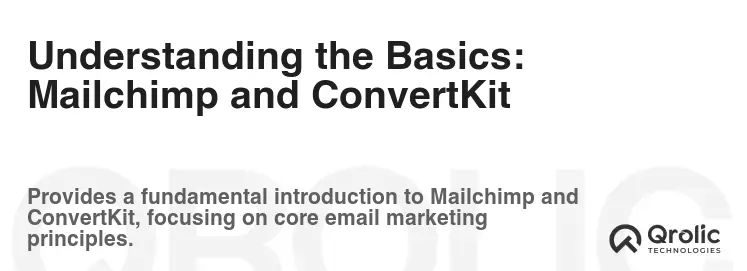
Before we dive into the specifics, let’s get a general overview of each platform:
Mailchimp: Mailchimp is a well-established and widely recognized email marketing platform, initially known for its user-friendly interface and free plan. It has evolved significantly over the years and now offers a broader range of marketing automation features, including website building, social media management, and even CRM functionalities. Mailchimp aims to be an all-in-one marketing platform for businesses of all sizes.
ConvertKit: ConvertKit, on the other hand, focuses squarely on email marketing for creators, bloggers, and businesses who prioritize audience segmentation and personalized communication. It’s designed to be intuitive and powerful, allowing users to create complex automation sequences without needing advanced technical skills. ConvertKit excels in serving those who want to build strong relationships with their subscribers and drive conversions.
Round 1: Core Features & Functionality

Let’s dissect the core offerings of each platform to see where their strengths lie:
Mailchimp: A Jack-of-All-Trades
- Email Marketing Campaigns: Mailchimp offers a robust campaign builder with drag-and-drop functionality, pre-designed templates, and A/B testing capabilities. You can create regular email blasts, automated emails, and transactional emails.
- Automation: Mailchimp’s automation features range from simple welcome series to more complex customer journeys based on behavior and engagement. However, advanced automation can be more complex to set up than in ConvertKit.
- List Management: Mailchimp traditionally relied on lists, which meant subscribers could exist on multiple lists. This has shifted with their introduction of an “Audience” concept, but the underlying structure can still feel a bit clunky for some users.
- Segmentation: Mailchimp allows you to segment your audience based on various criteria, including demographics, purchase history, and engagement. This enables you to personalize your messaging for different subscriber groups.
- Landing Pages: Mailchimp includes a landing page builder to create standalone pages for lead generation, product promotion, or event registration.
- Website Builder: Mailchimp offers a basic website builder, allowing you to create a simple online presence even if you don’t have a dedicated website.
- Social Media Management: Mailchimp provides tools to schedule and manage your social media posts from within the platform.
- CRM: Mailchimp has integrated CRM features, allowing you to track customer interactions and manage your sales pipeline.
- Reporting and Analytics: Mailchimp offers comprehensive reporting and analytics to track your email performance, website traffic, and social media engagement.
ConvertKit: Focus on Creators and Personalization
- Email Marketing Campaigns: ConvertKit provides a streamlined campaign builder with a focus on delivering personalized content to your subscribers. You can create broadcast emails, automated emails, and email sequences.
- Automation: ConvertKit excels in automation. Its visual automation builder allows you to create complex and personalized customer journeys with ease. You can trigger automations based on various actions, such as form submissions, link clicks, and purchase events.
- List Management: ConvertKit uses a tag-based system, where subscribers exist only once and are tagged based on their interests, behavior, and demographics. This provides a more flexible and organized way to manage your audience.
- Segmentation: ConvertKit’s tag-based system makes segmentation incredibly powerful. You can easily segment your audience based on any combination of tags, allowing you to send highly targeted and relevant emails.
- Landing Pages and Forms: ConvertKit offers a variety of customizable landing page and form templates designed for lead generation and subscriber growth. These are optimized for conversion and integrate seamlessly with your email marketing.
- Email Deliverability: ConvertKit prioritizes email deliverability and provides tools to help you optimize your sender reputation and ensure your emails reach your subscribers’ inboxes.
- Integrations: ConvertKit integrates seamlessly with a wide range of popular tools and platforms, including Shopify, wordpress, Teachable, and more.
- Reporting and Analytics: ConvertKit provides essential reporting and analytics to track your email performance, subscriber growth, and conversion rates.
The Verdict (Round 1):
- Mailchimp wins on breadth of features: It offers a wider range of tools beyond email marketing, making it a potential all-in-one solution.
- ConvertKit wins on focused excellence: It excels in email marketing automation, particularly for creators and businesses who prioritize personalized communication.
Round 2: Ease of Use and User Interface
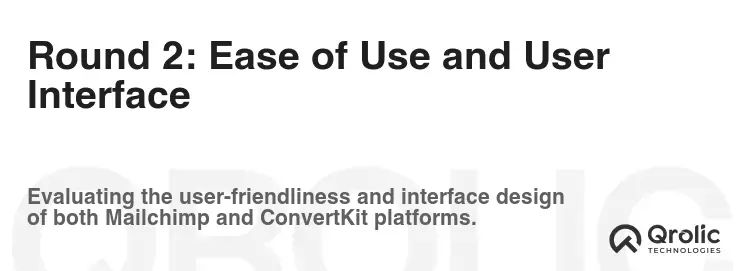
The usability of an email marketing tool is paramount. A complex interface can lead to frustration and wasted time.
Mailchimp: Familiar but Sometimes Cluttered
Mailchimp’s user interface is generally intuitive, especially for beginners. The drag-and-drop campaign builder is easy to use, and the platform offers a wealth of tutorials and documentation. However, as Mailchimp has added more features, the interface has become somewhat cluttered, and navigating to specific tools can sometimes be challenging. Some users also find the list-based system less flexible than ConvertKit’s tag-based approach.
ConvertKit: Streamlined and Focused
ConvertKit’s user interface is clean, modern, and focused on email marketing. The platform is designed to be intuitive and easy to navigate, even for users with limited technical experience. The visual automation builder is a standout feature, allowing you to create complex workflows with ease. The tag-based system also simplifies list management and segmentation.
The Verdict (Round 2):
- ConvertKit wins: Its cleaner, more focused interface and intuitive visual automation builder make it easier to use, especially for those who prioritize email marketing automation. While Mailchimp is familiar, its expanding feature set has led to a less streamlined experience.
Round 3: Pricing and Value for Money
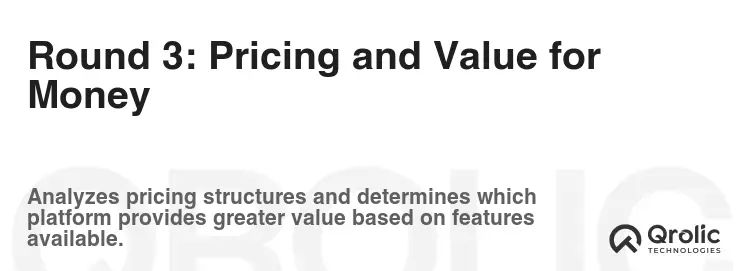
Pricing is always a critical factor. Understanding the pricing structure and what you get for your money is essential.
Mailchimp: Tiered Pricing with Complexity
Mailchimp offers a tiered pricing structure with four main plans: Free, Essentials, Standard, and Premium.
- Free Plan: Limited to 500 contacts and 1,000 emails per month. It includes basic email marketing features but lacks advanced automation and support.
- Essentials Plan: Starts at $13 per month for 500 contacts. It includes more email templates, A/B testing, and custom branding.
- Standard Plan: Starts at $20 per month for 500 contacts. It includes behavioral targeting, custom automation workflows, and dynamic content.
- Premium Plan: Starts at $350 per month for 10,000 contacts. It includes advanced segmentation, multivariate testing, and phone support.
Mailchimp’s pricing can become complex as your contact list grows and you need access to more advanced features. You also need to be mindful of the limitations of each plan and how they might impact your marketing strategy.
ConvertKit: Simple and Transparent Pricing
ConvertKit offers a simpler pricing structure based on the number of subscribers. They have a free plan and then paid creator and creator pro plans.
- Free Plan: Up to 300 subscribers. It includes unlimited landing pages and forms, email broadcasts, and community support.
- Creator Plan: Starts at $29 per month for 1,000 subscribers. It includes email sequences, automation, integrations, and premium support.
- Creator Pro Plan: Starts at $59 per month for 1,000 subscribers. It includes advanced reporting, Facebook custom audiences, and priority support.
ConvertKit’s pricing is more transparent and predictable than Mailchimp’s, especially as your contact list grows. You get access to all core features on the Creator plan, making it a good value for money for most users.
The Verdict (Round 3):
- It depends: Mailchimp’s free plan is attractive for beginners with very small lists. However, ConvertKit’s pricing is generally more transparent and offers better value for money as your list grows and you need access to more advanced features. ConvertKit’s “Creator” plan provides a comprehensive set of features at a competitive price point.
Round 4: Email Deliverability
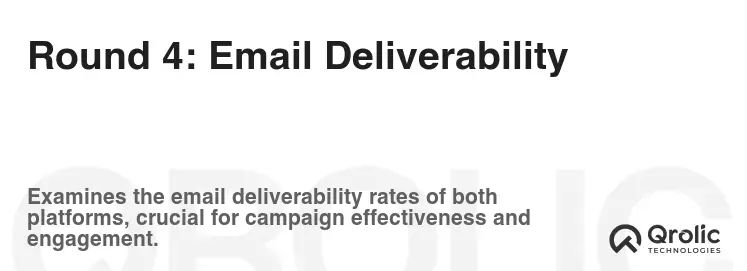
Getting your emails into the inbox is crucial. Email deliverability is a key factor in the success of any email marketing campaign.
Mailchimp: Reputation Management is Key
Mailchimp has a large user base, which can impact its overall email deliverability. If some users send spam or engage in poor email marketing practices, it can negatively affect the reputation of Mailchimp’s servers, potentially impacting the deliverability of emails sent by all users. Mailchimp actively monitors its platform and takes steps to prevent spam and maintain good deliverability. However, users need to follow best practices to ensure their emails reach the inbox.
ConvertKit: Prioritizing Inbox Placement
ConvertKit prioritizes email deliverability and takes several measures to ensure its users’ emails reach the inbox. They have a dedicated deliverability team that monitors the platform and works to maintain good relationships with ISPs. ConvertKit also provides tools and resources to help users optimize their sender reputation and avoid spam filters. Their focus on permission-based marketing and personalized communication further contributes to high deliverability rates.
The Verdict (Round 4):
- ConvertKit wins (slightly): Both platforms prioritize deliverability, but ConvertKit’s proactive approach and focus on personalized communication give it a slight edge. Mailchimp’s larger user base can make deliverability more variable, requiring users to be extra vigilant about following best practices.
Round 5: Customer Support
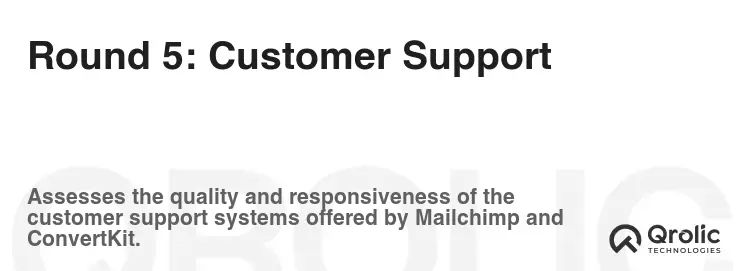
When things go wrong, reliable customer support is essential. The level of support offered can significantly impact your experience with a platform.
Mailchimp: Varied Support Based on Plan
Mailchimp’s customer support varies depending on your plan. Free users have access to limited email support, while paid users have access to email, chat, and phone support. However, response times can be slow, especially for free users. The quality of support can also be inconsistent.
ConvertKit: Responsive and Helpful Support
ConvertKit is known for its responsive and helpful customer support. They offer email and chat support to all paid users. Their support team is knowledgeable and dedicated to helping users succeed with the platform. They also have a comprehensive knowledge base and a community forum where users can find answers to common questions.
The Verdict (Round 5):
- ConvertKit wins: ConvertKit’s responsive and helpful customer support is a significant advantage, especially for users who need assistance with setting up and managing their email marketing campaigns. Mailchimp’s support can be less consistent and slower, especially for free users.
Round 6: Integrations
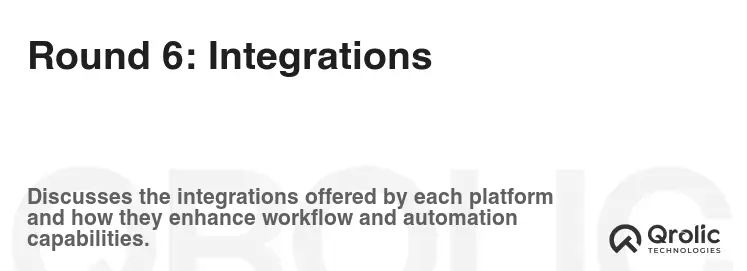
Integration with other tools and platforms is crucial for a seamless workflow. How well a platform integrates with your existing tech stack can save you time and effort.
Mailchimp: Extensive Integration Ecosystem
Mailchimp integrates with a wide range of popular tools and platforms, including Shopify, WordPress, Salesforce, and many more. They have a robust API that allows developers to build custom integrations. However, some integrations may require a paid plan.
ConvertKit: Focused Integrations for Creators
ConvertKit integrates seamlessly with a range of tools and platforms commonly used by creators, such as Shopify, WordPress, Teachable, and Zapier. They have a well-documented API that allows developers to build custom integrations. Their focus on integrations that support creators makes it easy to connect ConvertKit with your existing workflow.
The Verdict (Round 6):
- Mailchimp wins (slightly): While ConvertKit has excellent integrations for creators, Mailchimp’s broader ecosystem offers a wider range of integrations for different types of businesses.
The Ultimate Showdown: When to Choose Mailchimp vs. ConvertKit
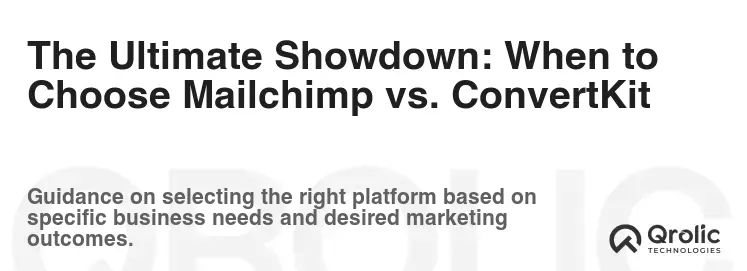
Now that we’ve analyzed the key features and functionalities of each platform, let’s break down the ideal use cases for Mailchimp and ConvertKit:
Choose Mailchimp If:
- You’re just starting out and need a free plan: Mailchimp’s free plan is a good option for beginners with very small lists.
- You need an all-in-one marketing platform: Mailchimp offers a wider range of marketing tools beyond email, including website building, social media management, and CRM.
- You need a wide range of integrations: Mailchimp’s extensive integration ecosystem makes it easy to connect with a variety of tools and platforms.
- You have a diverse audience and need basic segmentation: Mailchimp’s segmentation features are adequate for basic personalization.
- Price is your absolute primary concern: If you are starting out and you have a very constrained budget Mailchimp can be the answer to your Email Marketing.
Choose ConvertKit If:
- You’re a creator, blogger, or online business owner: ConvertKit is specifically designed for creators who prioritize building strong relationships with their subscribers.
- You need powerful email marketing automation: ConvertKit’s visual automation builder makes it easy to create complex and personalized customer journeys.
- You want a tag-based system for list management: ConvertKit’s tag-based system provides a more flexible and organized way to manage your audience.
- You prioritize email deliverability: ConvertKit’s proactive approach to deliverability helps ensure your emails reach the inbox.
- You value responsive and helpful customer support: ConvertKit’s support team is known for its expertise and dedication to helping users succeed.
- You are scaling and you want an easy way to automatically create a great experience for your subscribers.
- You have a specific persona you are targeting and want to use email as a way to connect and build loyalty with that target audience.
Qrolic Technologies: Your Partner in Email Marketing Success
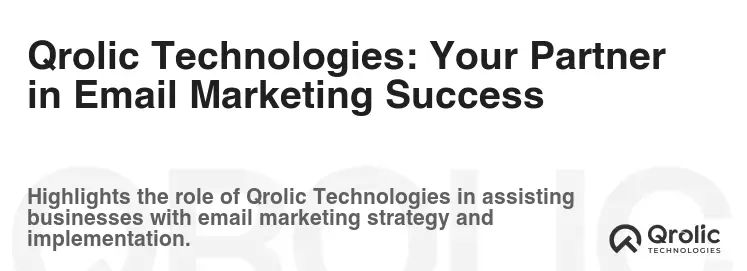
Choosing the right email marketing platform is only the first step. To truly maximize the impact of your email marketing efforts, you need a strategic partner with the expertise to help you develop and execute effective campaigns. That’s where Qrolic Technologies comes in.
Qrolic Technologies (https://qrolic.com/) is a leading digital marketing agency specializing in helping businesses of all sizes achieve their marketing goals. We offer a comprehensive suite of services, including:
- Email Marketing Strategy: We work with you to develop a customized email marketing strategy that aligns with your business objectives and target audience.
- Email Template Design: Our expert designers create visually appealing and engaging email templates that reflect your brand identity.
- Automation Setup and Management: We can help you set up and manage complex automation workflows in Mailchimp or ConvertKit to nurture leads and drive conversions.
- List Segmentation and Targeting: We use advanced segmentation techniques to ensure your emails reach the right subscribers with the right message.
- Email Deliverability Optimization: We monitor your email deliverability and implement best practices to ensure your emails reach the inbox.
- Analytics and Reporting: We provide detailed analytics and reporting to track your email performance and identify areas for improvement.
Whether you’re just starting out with email marketing or looking to optimize your existing campaigns, Qrolic Technologies has the expertise and experience to help you succeed. We can help you choose the right platform, develop a winning strategy, and execute effective campaigns that drive results. We help you in designing the best and converting email marketing automation software.
Conclusion: The Verdict is in… It Depends!
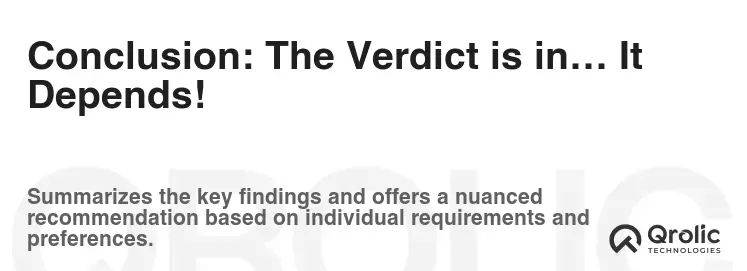
There’s no one-size-fits-all answer to the question of Mailchimp vs. ConvertKit. The best email marketing tool for you depends on your specific needs, budget, and technical expertise.
- For beginners and those needing an all-in-one platform, Mailchimp is a viable starting point.
- For creators, bloggers, and businesses prioritizing personalized communication and automation, ConvertKit is the clear winner.
Ultimately, the best way to decide is to try both platforms and see which one feels like the best fit for your workflow and business goals. Take advantage of free trials or free plans to experiment with the features and interface of each platform. And remember, a strategic partner like Qrolic Technologies can help you navigate the complexities of email marketing and achieve your desired results, regardless of which platform you choose. Don’t just pick email marketing tools, create a robust email marketing strategy for your brand, with the perfect tool!

